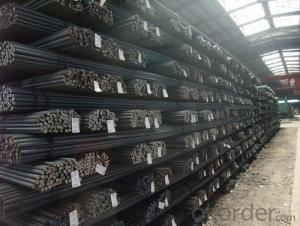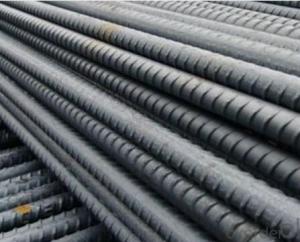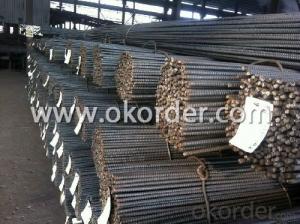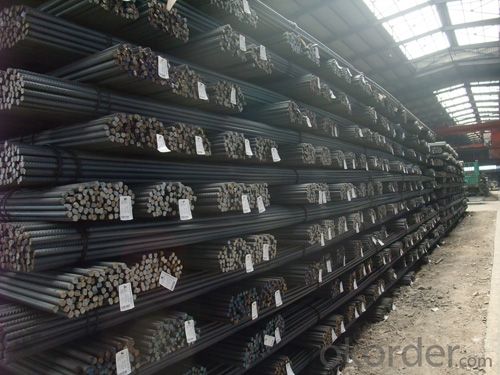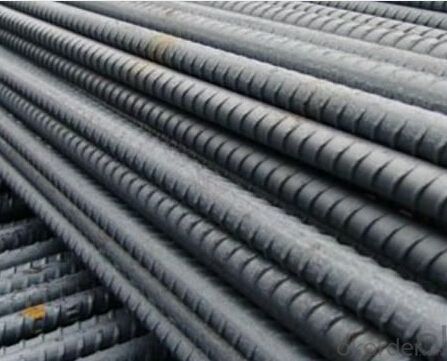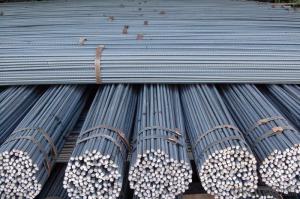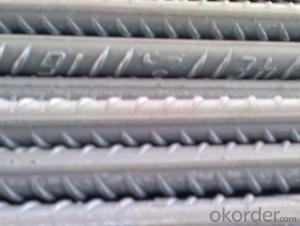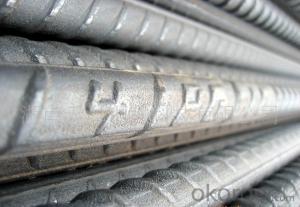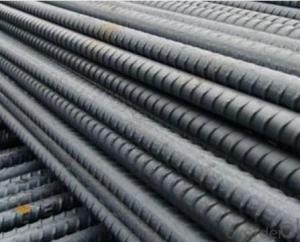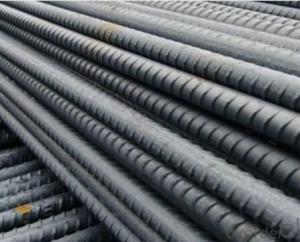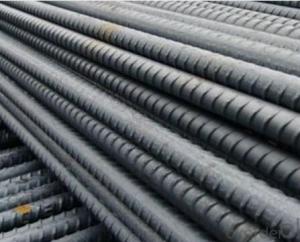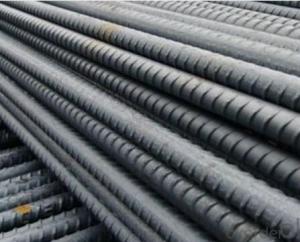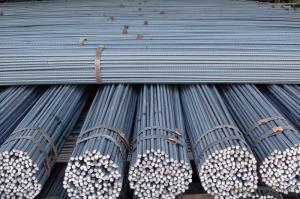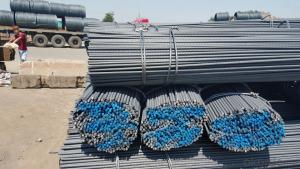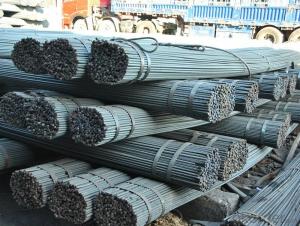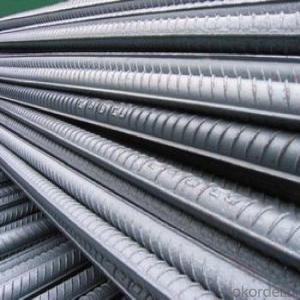HIGH QUALITY HOT ROLLED STEELDIN STANDARD REBAR
- Loading Port:
- Tianjin
- Payment Terms:
- TT OR LC
- Min Order Qty:
- 50 m.t.
- Supply Capability:
- 100000 m.t./month
OKorder Service Pledge
OKorder Financial Service
You Might Also Like
Product Description:
Specifications of Hot Rolled Steel Rebar:
The production process of Steel Rebar
1-Waling beam furnace 2-Roughing rolling group 3-Intermediate rolling train
4-Finishing rolling group 5-Water-cooling device 6-Walking beam cooler
7-Finishing equipment(including the cold scale shear,short feet collection system,
automatic counting device,bundling machine, collect bench)
Usage and Applications of Hot Rolled Steel Rebar:
Deformed bar is widely used in buildings, bridges, roads and other engineering construction. Big to highways, railways, bridges, culverts, tunnels, public facilities such as flood control, dam, small to housing construction, beam, column, wall and the foundation of the plate, deformed bar is an integral structure material. With the development of world economy and the vigorous development of infrastructure construction, real estate, the demand for deformed bar will be larger and larger..
Packaging & Delivery of Hot Rolled Steel Rebar:
Packaging Detail: products are packed in bundle and then shipped by container or bulk vessel, deformed bar is usually naked strapping delivery, when storing, please pay attention to moisture proof. The performance of rust will produce adverse effect.
Each bundle weight: 2-3MT, or as required
Payment terms: TT payment in advance or Irrevocable LC at sight.
Trade terms :FOB, CFR, CIF
Label:to be specified by customer, generally, each bundle has 1-2 labels
Note:
1. Our products are produced according to national standard (GB), if not, supply according to national standards (GB) or agreement as customer required.
2. Other Grade and Standard Deformed Steel Bar we can supply:
Grade: GR40/GR60, G460B/B500A/B500B/B500C,BST500S
Standard: ASTM, BS, DIN
The Minimum Order Quantity of these products is high, and need to be confirmed.
3. We can not only supply Deformed Steel Bar; if you need anything about building materials, please contact us for further information.
4. Please send us your detail specifications when inquire. We will reply to you as soon as possible. We sincerely hope we can establish a long stable business relationship.
- Q: How are steel rebars protected during storage and transportation?
- Steel rebars are typically protected during storage and transportation through various measures such as wrapping them in moisture-resistant materials, applying anti-corrosion coatings, and storing them in covered areas or enclosed containers to shield them from environmental factors like moisture, dirt, and physical damage.
- Q: What are the guidelines for the proper spacing of steel rebars in beams?
- Engineering standards and codes determine the guidelines for the proper spacing of steel rebars in beams, ensuring the beam's structural integrity and strength. Here are some general considerations: 1. Rebar spacing: The spacing between rebars should allow for proper concrete placement and consolidation. Typically, this spacing is measured in terms of rebar diameter or as a percentage of the beam depth. Specific requirements may vary based on factors such as beam size, load requirements, and design specifications. 2. Minimum and maximum spacing: Rebars in beams usually have minimum and maximum spacing requirements. The minimum spacing ensures adequate concrete cover to protect the rebar from corrosion and provide fire resistance. Maximum spacing helps distribute loads evenly and prevent excessive concrete cracking. 3. Concrete cover: Rebars should be sufficiently covered by concrete to protect against corrosion and provide fire resistance. Concrete cover is the distance between the rebar's outer surface and the beam's edge. Required cover is specified in engineering codes, considering factors like exposure conditions, durability requirements, and fire ratings. 4. Spacing around supports and openings: Special attention should be given to rebar spacing around supports (e.g., columns, walls) and openings (e.g., doorways, windows). These areas may experience higher stresses and require additional reinforcement. Engineering codes provide specific requirements based on support or opening size and shape. 5. Lateral and longitudinal reinforcement: In addition to longitudinal reinforcement (rebar spacing along the beam's length), beams may need additional reinforcement in the form of stirrups or ties (lateral reinforcement). These elements resist shear forces and prevent diagonal cracking. Spacing and size of additional reinforcement depend on design requirements and load conditions. It's important to note that specific guidelines for rebar spacing in beams may vary based on regional building codes, project specifications, and engineering standards. Consultation with a qualified structural engineer or reference to applicable codes and design documents is crucial for accurate and up-to-date guidelines.
- Q: What is the role of steel rebars in beam and column design?
- The role of steel rebars in beam and column design is crucial, as they serve to reinforce and enhance the structural integrity of these elements. In reinforced concrete structures, rebars are utilized to withstand tensile forces that concrete alone is unable to bear. When it comes to beams, it is common practice to position rebars at the bottom to counteract the tensile stresses caused by bending moments. By distributing the load along the length of the beam, rebars effectively bolster its strength and prevent the occurrence of cracks or failures. The tension-resisting ability of rebars is instrumental in maintaining the beam's shape and its capacity to bear loads, thereby ensuring the overall stability of the entire construction. Similarly, in columns, rebars are placed throughout their length to withstand both axial and bending forces. They enhance the column's capacity to endure compression, while simultaneously offering additional resistance against lateral loads from seismic or wind forces. The presence of rebars in columns significantly amplifies their load-bearing capability and overall stability. To summarize, steel rebars play a pivotal role in beam and column design by providing reinforcement against tensile forces, augmenting structural strength, averting cracks, and guaranteeing the overall stability and safety of the structure.
- Q: What is the role of steel rebars in reinforced concrete beams?
- The role of steel rebars in reinforced concrete beams is to provide tensile strength and reinforcement to the concrete. Concrete is strong in compression but weak in tension, so the steel rebars are embedded within the concrete to carry the tensile forces and prevent cracking or failure of the beam. The rebars distribute the applied loads throughout the beam, increasing its overall strength and durability.
- Q: What are the main characteristics of steel rebars?
- Steel rebars, also known as reinforcing bars, possess several key characteristics that make them an essential component in construction and engineering projects. Firstly, steel rebars exhibit exceptional strength and durability. They are primarily made from carbon steel, which provides high tensile strength, enabling them to withstand heavy loads and stresses without deformation or failure. This strength makes them crucial for reinforcing concrete structures, enhancing their structural integrity and resistance to bending, cracking, and shear forces. Another important characteristic of steel rebars is their corrosion resistance. Since steel can be prone to rusting when exposed to moisture and air, rebars are often coated with epoxy or other protective materials to prevent corrosion. This ensures the longevity and durability of the reinforced concrete structures, making them suitable for various environments, including marine or high humidity areas. Furthermore, steel rebars possess excellent thermal conductivity, allowing them to effectively disperse heat, which is particularly important in structures subjected to extreme temperatures or fire hazards. They also have good bonding properties with concrete due to their ribbed or deformed surface. This textured surface enhances the adhesion between the rebar and the concrete, preventing slippage and providing improved structural stability. Additionally, steel rebars are versatile and can be easily shaped and bent to fit the required design or specifications of a construction project. They are available in various sizes, lengths, and grades, allowing engineers and architects to select the appropriate type of rebar based on the specific load-bearing requirements of the structure. In summary, the main characteristics of steel rebars include their strength, durability, corrosion resistance, thermal conductivity, bonding properties, and versatility. These qualities make steel rebars an essential component in construction, ensuring the safety, stability, and longevity of reinforced concrete structures.
- Q: Are there any specific guidelines for storing steel rebars on-site?
- Storing steel rebars on-site requires following specific guidelines. Consider the following key guidelines: 1. To prevent distortion or bending, rebars should be stored on a flat, level surface. If the ground is uneven, create a stable storage area using wooden pallets or metal racks. 2. The storage area must be clean and free from debris that could damage the rebars. Avoid storing rebars directly on the ground or in areas prone to water accumulation. 3. Proper stacking is crucial to prevent rebars from toppling over. Stack them in an organized manner, aligning them vertically and horizontally. Use spacers or separators to maintain adequate spacing between the rebars and prevent contact. 4. When storing rebars outdoors, protect them from rain, snow, and moisture by covering them with a waterproof tarp or plastic sheeting. This prevents rust and corrosion. 5. If rebars are stored indoors, ensure proper ventilation to prevent moisture buildup. This is especially important in humid environments to prevent rusting. 6. Keep rebars away from potential sources of damage, such as heavy machinery, construction equipment, or high-traffic areas. This reduces the risk of accidental damage during construction activities. 7. Regularly inspect the rebars for any signs of damage, rust, or corrosion. If any rebars are found to be damaged, remove them from storage and replace them to maintain structural integrity in the construction project. By adhering to these guidelines, steel rebars can be stored safely while maintaining their structural integrity for use in construction projects.
- Q: What are the dimensions and sizes of steel rebars?
- Steel rebars, also known as reinforcing bars, come in various dimensions and sizes. The most common sizes range from #3 to #18, with diameters ranging from 3/8 inch to 2 1/4 inches. The length of rebars typically varies from 20 feet to 60 feet, but can also be customized to meet specific project requirements. Additionally, rebars are available in different shapes, such as round, square, or deformed, to enhance their bonding with concrete.
- Q: What is the role of steel rebars in earthquake-resistant structures?
- The role of steel rebars in earthquake-resistant structures is crucial. Steel rebars, or reinforcing bars, are used to reinforce concrete structures and provide additional strength and stability, making them more resistant to the destructive forces of an earthquake. During an earthquake, the ground shakes violently, exerting immense pressure and causing the structure to undergo significant stress. Without proper reinforcement, the concrete alone may not be able to withstand these forces, leading to structural failure and potential collapse. Steel rebars are typically embedded within the concrete, forming a strong bond with it. These rebars act as a skeleton or framework, distributing the load and stress evenly throughout the structure. They enhance the tensile strength of concrete, which is naturally weak in tension but strong in compression. By providing resistance against bending, shearing, and tensile forces, steel rebars help prevent cracks and limit the extent of damage caused by seismic activity. Furthermore, the presence of steel rebars allows for better ductility in the structure. Ductility is the ability of a material to deform without breaking or fracturing. In the event of an earthquake, the steel rebars can stretch and flex, absorbing and dissipating energy, thereby reducing the impact on the concrete and minimizing structural damage. The combination of the rigid concrete and the flexible steel rebars creates a system that can withstand the lateral forces and vibrations produced during an earthquake. In essence, steel rebars play a crucial role in earthquake-resistant structures by reinforcing concrete, improving its tensile strength, enhancing ductility, and providing overall stability. Their inclusion in the design and construction of buildings and infrastructure is essential to ensure the safety and resilience of these structures in seismic zones.
- Q: What is the effect of exposure to UV radiation on steel rebars?
- Exposure to UV radiation can cause degradation and weakening of steel rebars. The radiation can break down the protective oxide layer on the surface of the steel, leading to corrosion and rust formation. This can compromise the structural integrity of the rebars and potentially lead to structural failures in concrete structures. Therefore, it is important to protect steel rebars from prolonged exposure to UV radiation to ensure their long-term durability and safety.
- Q: How do steel rebars prevent concrete structures from spalling?
- Steel rebars prevent concrete structures from spalling by providing reinforcement and increasing the overall strength of the concrete. Spalling refers to the cracking and breaking off of the concrete surface, usually due to the expansion of internal pressure from various external factors such as temperature changes, moisture, or structural loads. When steel rebars are embedded within the concrete, they act as a support system that helps distribute the applied loads more evenly throughout the structure. This reinforcement prevents localized stress concentrations, which can lead to spalling, by absorbing and dissipating the load. By reinforcing the concrete, rebars enhance its tensile strength and improve its ability to withstand external forces. Moreover, steel rebars also help to control the formation of cracks in the concrete. As concrete is a brittle material with low tensile strength, it is prone to cracking under stress. However, the presence of rebars inhibits the propagation of cracks by bridging them and transferring the stress to the surrounding concrete. This prevents the cracks from spreading and ultimately leads to a more durable and resilient structure. Additionally, steel rebars provide protection against corrosion. Concrete is naturally alkaline, which creates a protective layer on the steel surface, preventing it from rusting. This alkaline environment acts as a barrier against corrosion, ensuring the rebars maintain their structural integrity over time. By avoiding corrosion, the rebars can continue to provide reinforcement and prevent spalling in the concrete structure. In summary, steel rebars play a crucial role in preventing spalling in concrete structures by providing reinforcement, improving tensile strength, controlling crack formation, and protecting against corrosion. By enhancing the overall stability and durability of the concrete, rebars ensure that the structure can withstand various external pressures and maintain its integrity for an extended period.
Send your message to us
HIGH QUALITY HOT ROLLED STEELDIN STANDARD REBAR
- Loading Port:
- Tianjin
- Payment Terms:
- TT OR LC
- Min Order Qty:
- 50 m.t.
- Supply Capability:
- 100000 m.t./month
OKorder Service Pledge
OKorder Financial Service
Similar products
Hot products
Hot Searches
Related keywords
